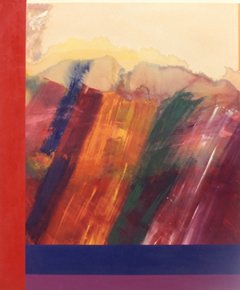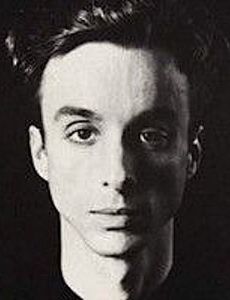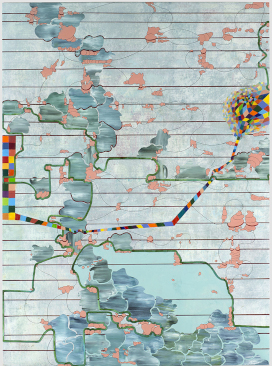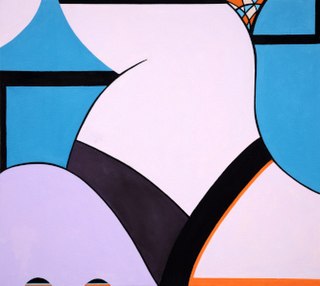
Paul Jackson Pollock was an American painter. A major figure in the abstract expressionist movement, Pollock was widely noticed for his "drip technique" of pouring or splashing liquid household paint onto a horizontal surface, enabling him to view and paint his canvases from all angles. It was called all-over painting and action painting, since he covered the entire canvas and used the force of his whole body to paint, often in a frenetic dancing style. This extreme form of abstraction divided critics: some praised the immediacy of the creation, while others derided the random effects.
Abstract expressionism in the United States emerged as a distinct art movement in the immediate aftermath of World War II and gained mainstream acceptance in the 1950s, a shift from the American social realism of the 1930s influenced by the Great Depression and Mexican muralists. The term was first applied to American art in 1946 by the art critic Robert Coates. Key figures in the New York School, which was the center of this movement, included such artists as Arshile Gorky, Jackson Pollock, Franz Kline, Mark Rothko, Norman Lewis, Willem de Kooning, Adolph Gottlieb, Clyfford Still, Robert Motherwell and Theodoros Stamos among others.

Lenore "Lee" Krasner was an American painter and visual artist active primarily in New York whose work has been associated with the Abstract Expressionist movement. She received her early academic training at the Women's Art School of Cooper Union, and the National Academy of Design from 1928 to 1932. Krasner's exposure to Post-Impressionism at the newly opened Museum of Modern Art in 1929 led to a sustained interest in modern art. In 1937, she enrolled in classes taught by Hans Hofmann, which led her to integrate influences of Cubism into her paintings. During the Great Depression, Krasner joined the Works Progress Administration's Federal Art Project, transitioning to war propaganda artworks during the War Services era.
Gilles Peress is a French photographer and a member of Magnum Photos.

Ronnie Landfield is an American abstract painter. During his early career from the mid-1960s through the 1970s his paintings were associated with Lyrical Abstraction, and he was represented by the David Whitney Gallery and the André Emmerich Gallery.
The Art of This Century gallery was opened by Peggy Guggenheim at 30 West 57th Street in Manhattan, New York City on October 20, 1942. The gallery occupied two commercial spaces on the seventh floor of a building that was part of the midtown arts district including the Museum of Modern Art, the Museum of Non-Objective Painting, Helena Rubinstein's New Art Center, and numerous commercial galleries. The gallery exhibited important modern art until it closed in 1947, when Guggenheim returned to Europe. The gallery was designed by architect, artist, and visionary Frederick Kiesler.
Marjorie Welish is an American poet, artist, and art critic.
Jonathan Podwil is an American painter and experimental filmmaker living and working in Brooklyn, New York. He is known for paintings based on film and photography and often have oblique references to historical events. In addition he has made short super8 films which are digitally manipulated and presented as looped animations.

Robert Carleton Hobbs is an American art historian and curator specializing in twentieth-century art. Since 1991 he has held the Rhoda Thalhimer Endowed Chair of American Art in the School of Arts, Virginia Commonwealth University, a highly ranked art department. Since 2004 he has served as a visiting professor at Yale University. He has held positions at Cornell University, University of Iowa, Florida State University, and Tehran Museum of Contemporary Art in Iran, and is known for a number of books, in-depth essays, and exhibitions.
Carrie Moyer is an American painter and writer living in Brooklyn, New York. Moyer's paintings and public art projects have been exhibited both in the US and Europe since the early 1990s, and she is best known for her 17-year agitprop project, Dyke Action Machine! with photographer Sue Schaffner. Moyer's work has been shown at the Whitney Biennial, the Museum of Arts and Design, and the Tang Museum, and is held in the permanent collections of the Metropolitan Museum of Art. She serves as the director of the graduate MFA program at Hunter College, and has contributed writing to anthologies and publications like The Brooklyn Rail and Artforum.
Andrew Cornell Robinson is an American artist and designer. He is based in New York City.

Hugh Auchincloss Steers was an American painter whose work is in the Metropolitan Museum of Art, the Whitney Museum of American Art, the Walker Art Center, and the Denver Art Museum. He died of AIDS at the age of 32.
Arnold J. Kemp is an American artist who works in painting, print, sculpture, and poetry. After graduating from Boston Latin School, Kemp received a BA/BFA from Tufts University and the School of the Museum of Fine Arts Boston, and an MFA from Stanford University.

Lisa Corinne Davis is an American visual artist known for abstract paintings and works on paper that suggest maps and other encoded forms of knowledge. She employs abstraction as a means of rendering the complexities of contemporary experience—including her own as an African-American woman—often questioning preconceived notions about identity, classification, and rationality versus subjectivity. Her densely layered, colorful work merges contrasting schemas, visual elements and formal languages, blurring distinctions between figuration and abstraction, real and fictive spaces and concepts, and microcosmic or macrocosmic reference. Brooklyn Rail critic Joan Waltemath wrote, "The urban experiences of space and time that Davis presents are subtle distillations of moment and coincidence ... Her attempt to map the shattered terrain of contemporary life points both to an awareness of other times and a belief in navigating the present one."

Harry Kramer is an American abstract painter, born in Philadelphia, Pennsylvania. In 1962 he received a BFA from The University of Arts and earned an MFA from Yale University in 1965.

Ray Ciarrocchi is a New York-based figurative painter. Ciarrocchi has presented numerous solo exhibitions in New York, additional US cities and Italy as well as dozens of group exhibitions in varied locations and venues. His paintings, watercolors, drawings and monotypes are in many museum and private collections both nationally and abroad.
Morgan O'Hara, is a conceptual artist based in Venice who works in performative drawing and social practice.
Anna Conway is an American visual artist based in New York City and known for enigmatic oil paintings that depict uneasy, absurdist moments descending on isolated, ordinary individuals. She combines a style identified as precise and methodical with detailed observation, "an air of surrealist suspension," and a narrative sense that critics characterize as elusive, metaphysical and "imbued with cinematic suggestion." Conway has exhibited nationally and internationally, including at MoMA PS1, the American Academy of Arts and Letters, Kemper Museum of Contemporary Art, University Art Museum at Albany, Fralin Museum of Art, and Collezione Maramotti (Italy), among other venues. She has been recognized with a Guggenheim Fellowship (2014), two Pollock-Krasner Foundation Awards, and the American Academy of Arts and Letters William L. Metcalf Award (2008).

Harriet Korman is an American abstract painter based in New York City, who first gained attention in the early 1970s. She is known for work that embraces improvisation and experimentation within a framework of self-imposed limitations that include simplicity of means, purity of color, and a strict rejection of allusion, illusion, naturalistic light and space, or other translations of reality. Writer John Yau describes Korman as "a pure abstract artist, one who doesn’t rely on a visual hook, cultural association, or anything that smacks of essentialization or the spiritual," a position he suggests few post-Warhol painters have taken. While Korman's work may suggest early twentieth-century abstraction, critics such as Roberta Smith locate its roots among a cohort of early-1970s women artists who sought to reinvent painting using strategies from Process Art, then most associated with sculpture, installation art and performance. Since the 1990s, critics and curators have championed this early work as unjustifiably neglected by a male-dominated 1970s art market and deserving of rediscovery.

Amanda Church is an American artist known for abstract paintings that reference the human figure and other discernible elements. Her works straddle representational and formalist art traditions, suggesting recognizable body parts, objects, and perspectival elements in an otherwise abstract field. Church's distinctive use of contrasting style elements has been consistently noted by critics such as Hyperallergic's Cora Fisher, who described Church's work as "whimsically overruling the left-right brain dichotomy as well as the traditionally gendered axis that divides geometric and decorative art." Church received a Guggenheim Fellowship in 2015 and a Pollock-Krasner Foundation grant in 2017, among other awards. Her work has been covered in publications such as The New York Times, The Boston Globe, ARTnews, Hyperallergic and Forbes Magazine. Her paintings have been exhibited in major U.S. cities as well as internationally, in galleries and museums such as the Brooklyn Museum of Art and the Aldrich Museum. She lives and works in New York.











